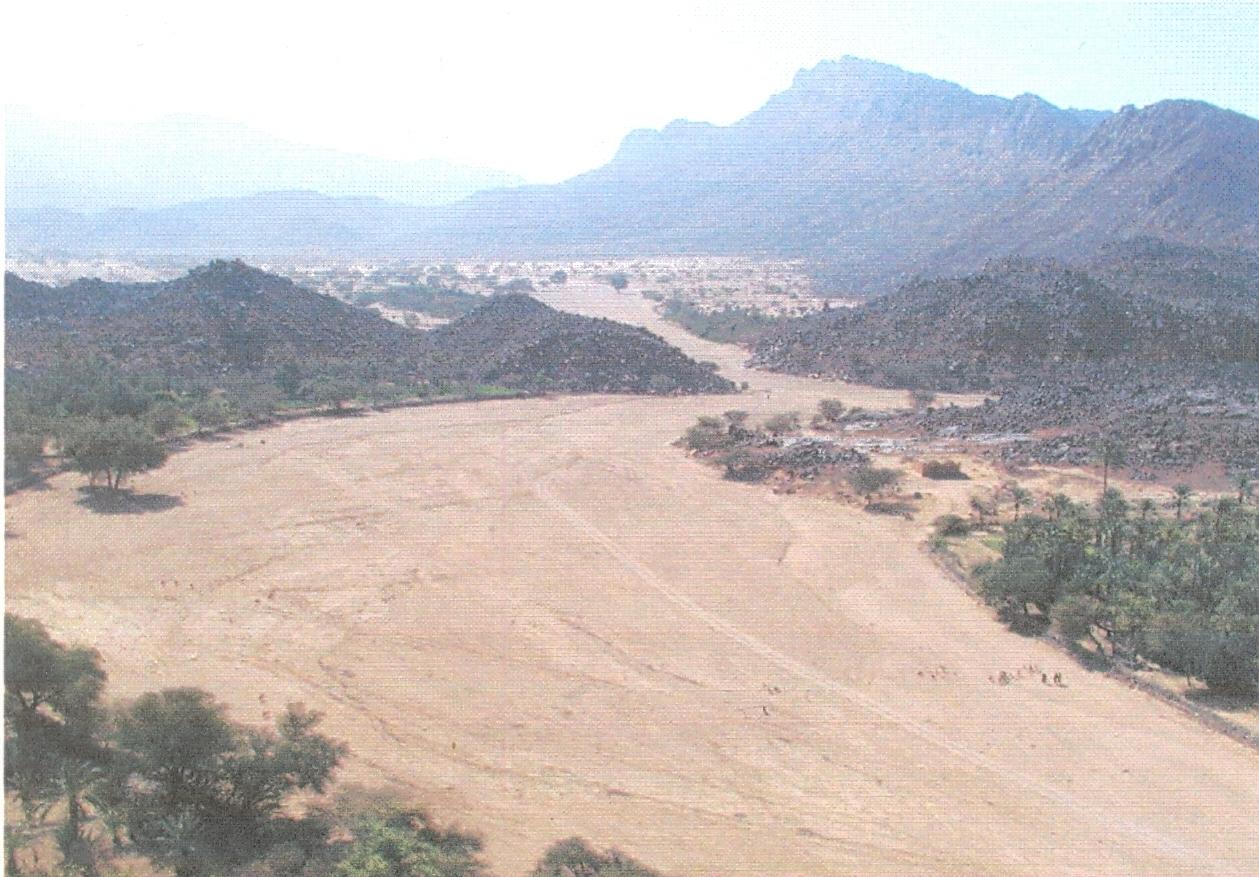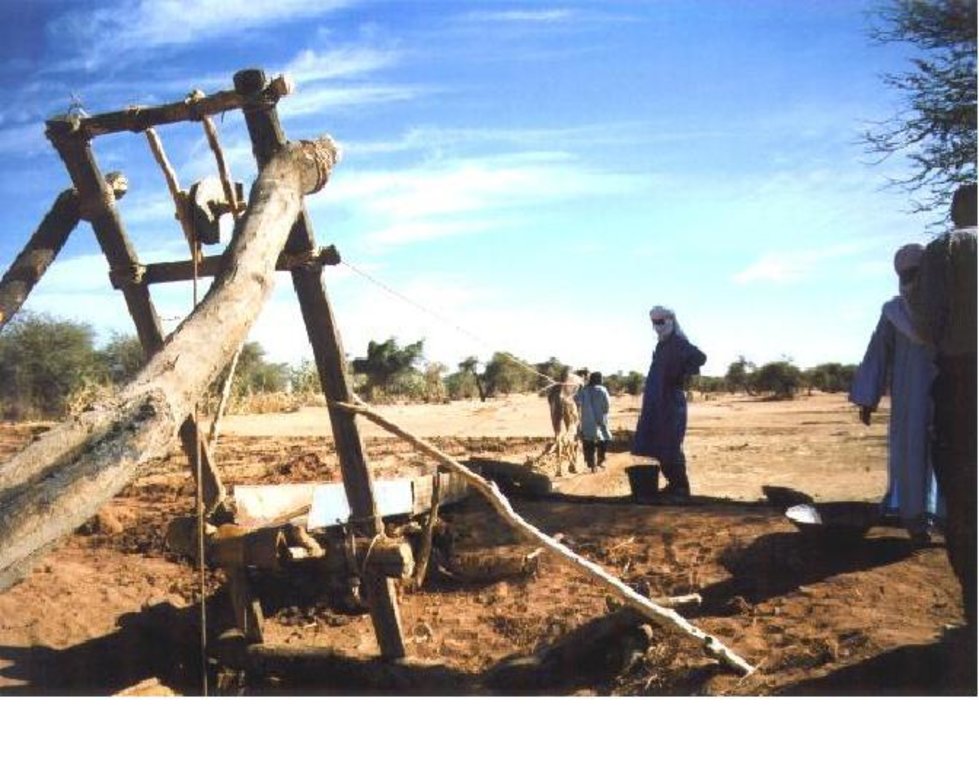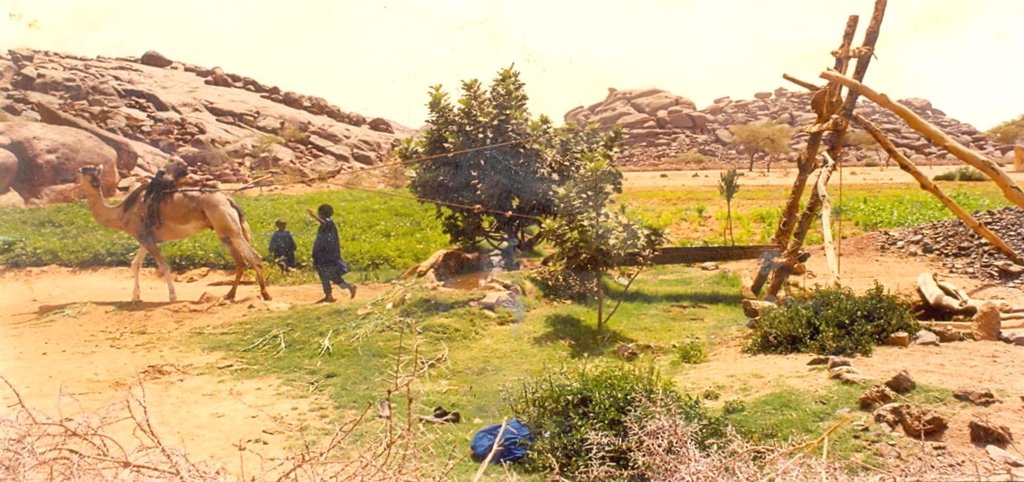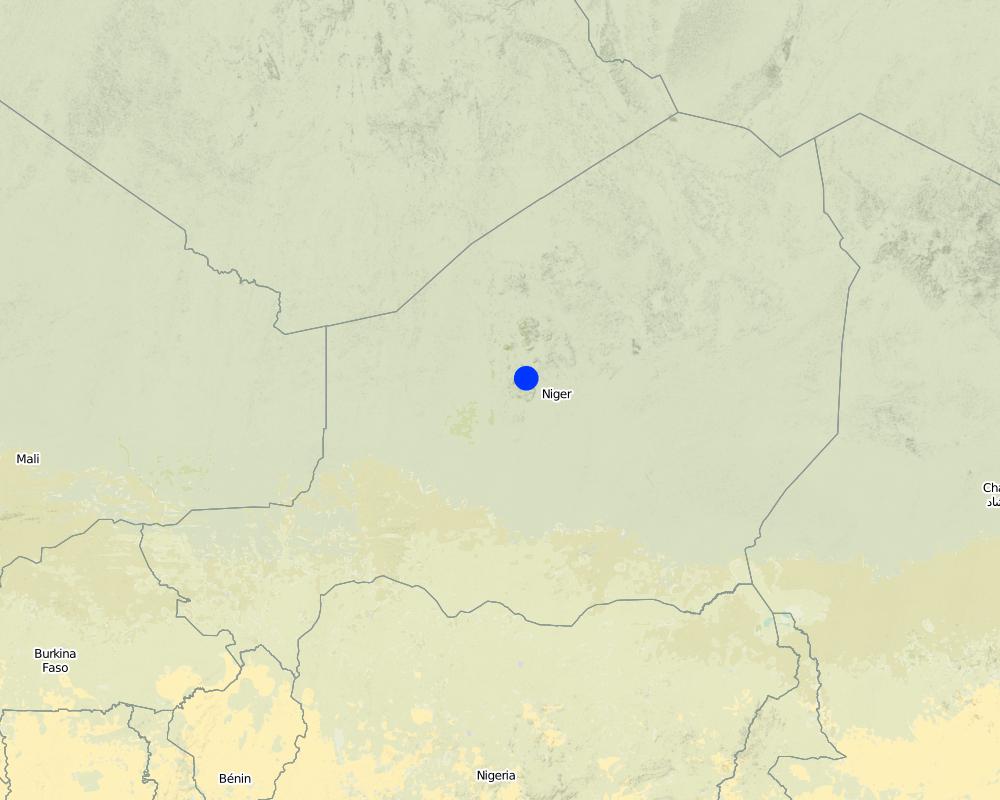Irrigated Oasis gardens [النيجر]
- تاريخ الإنشاء:
- تحديث:
- جامع المعلومات: Soumaila Abdoulaye
- المحرر: –
- المراجعون: Alexandra Gavilano, David Streiff, Deborah Niggli
technologies_947 - النيجر
عرض الأقسام
توسيع الكل طي الكل1. معلومات عامة
1.2 تفاصيل الاتصال بالأشخاص الرئيسيين لمصدر المعلومات والمؤسسات المشاركة في تقييم وتوثيق التقنية
اسم المشروع الذي سهّل توثيق/تقييم التقنية (إذا كان ذلك على صلة)
Book project: SLM in Practice - Guidelines and Best Practices for Sub-Saharan Africa (SLM in Practice)اسم المؤسسة (المؤسسات) التي سهلت توثيق/تقييم التقنية (إذا كان ذلك على صلة)
GREAD (GREAD) - النيجر1.3 الشروط المتعلقة باستخدام البيانات الموثقة من خلال WOCAT
يوافق جامع المعلومات والشخص (لاشخاص) الرئيسي لمصدر المعلومات على الشروط المتعلقة باستخدام البيانات الموثقة من خلال WOCAT:
نعم
2. وصف تقنيةالإدارة المستدامي للأراضي
2.1 وصف مختصر للتقنية
تعريف التقنية:
Oasis gardens in Niger for crop, vegetable and fruit production are supplied with irrigation water from traditional wells.
2.2 وصف تفصيلي للتقنية
الوصف:
In Timia Oasis in Aïr, small irrigated gardens (< 0.3 ha) have been used for over a century, producing dates and tree crops (figs, citrus, cherries, etc.) for sale and cereals for consumption (wheat, maize and pearl millet). With the onion boom in the 1990s, the establishment of new gardens grew dramatically. The new gardens cover a bigger area (0.5 - 1 ha) and focus on cash crops - mainly onions, but also potatoes and garlic. Gardens are fenced using branches from acacia trees. The water supply system in most cases is based on traditional wells with an animal-drawn scoop. The wells are less than 20 meters deep and generally built without a casing. Local experts were trained by GTZ project staff in well construction and maintenance. Modern motor pumps have recently become common and are used in new gardens. Water is conveyed to the plots through a hand-dug network of distribution channels. The channels are lined with clay and stones to minimize water loss through infiltration, evaporation, or breaching. Irrigating a whole garden takes about two hours. There are two cropping seasons per year: the rainy season (June-Sept) with staple crops such as maize and millet; and the dry/cold season (Oct.-Feb.) with wheat-barley associations and cash crops such as onions, garlic, tomatoes and vegetables. Fruit trees covering up to a fifth of the gardens; one section of the garden is reserved for keeping small ruminants. Agricultural residues are used as fodder and manure produced by livestock ensures fertility of gardens in combination with inorganic fertilizers. Traditional techniques (local plants, ash, etc) are used for pest management. Seed production and selection is done strictly locally.
Establishment / maintenance activities and inputs: The main establishment activities for this technology are: 1. Identify and demarcate of a free area to be converted into a garden. Fence area with acacia branches and living hedge. 2. Establish a traditional or cement well, max. 2 m wide and 15-20 m deep (contract with local well builder) in the middle of the field. 3. Installation of traditional water conveyance system (Tekarkat): wooden poles hold a pulley which conducts a rope with a scoop for extraction of water from the well. The system is powered by a dromedary. A 5-meter-chute (palm stem or iron sheet) conducts the water to a small reservoir.
4. Mark and dig irrigation canal system and basins for crop cultivation (8 m2): Main canal and secondary canals (perpendicular to main canal) are reinforced with clay or stones. 5. Purchase inputs (local market): seed, seedlings, fertilizer, tools. 6. Plant fruit trees.
Maintenance activities are the following: 1. Maintenance of fence: replace missing branches; plant new tree seedlings to reinforce the living hedge (biannually). 2. Irrigation (daily). 3. Maintenance of Tekarkat and canal system: control (and replace) poles; periodic weeding, cleaning, repair leaks and improve lining with clay/stones (biannually, after harvest). 4. Field preparation and application of organic manure (beginning of each cropping season). 5. Maintenance of well: cleaning (hot season), reinforce walls with cement (if needed).
6. Feeding draught animal using natural grassland and crop residues.
2.3 صور التقنية
2.5 البلد/المنطقة/المواقع التي تم تنفيذ التقنية فيها والتي يغطيها هذا التقييم
البلد:
النيجر
المنطقة/الولاية/المحافظة:
Aïr
مزيد من التفاصيل حول الموقع:
Timia oasis
حدد انتشار التقنية:
- يتم تطبيقها في نقاط محددة/ تتركز على مساحة صغيرة
Map
×2.6 تاريخ التنفيذ
في حالة عدم معرفة السنة بالتحديد، يرجى الإشارة إلى التاريخ التقريبي:
- منذ 10-50 سنة
2.7 إدخال التقنية
حدد كيف تم إدخال التقنية:
- من خلال ابتكار مستخدمي الأراضي
التعليقات (نوع المشروع، الخ):
These traditional gardens tend to be adopted spontaneously. The technology was a response to the successive droughts of the 1970s and 1980s that caused large livestock losses in the region. Nomadic herders have adopted technology to diversify their livelihoods and reduce risks. Since the 1990s, 700 new gardens have been created in Timia (compared to the 100 that previously existed)
3. تصنيف تقنية الإدارة المستدامي للأراضي
3.1 الغرض الرئيسي ( الأغراض الرئيسية) للتقنية
- تحسين الإنتاج
3.2 نوع (أنواع) استخدام الأراضي الحالية حيث يتم تطبيق التقنية

الأراضي الزراعية
- زراعة سنوية
- زراعة الأشجار والشجيرات
الزراعة السنوية - حدد المحاصيل:
- الحبوب - الذرة
- الحبوب - الدخن
- الخضروات - الخضروات الجذرية (الجزر والبصل والشمندر وغيرها)
- المحاصيل الجذرية/الدرنية - البطاطس
- wheat
زراعة الأشجار والشجيرات -حدد المحاصيل:
- الموالح (الحمضيات)
- التين
- الفواكه ذات النواة (الخوخ، المشمش، الكرز، البرقوق، الخ)
عدد مواسم الزراعة في السنة:
- 2
حدد:
Longest growing period in days: 150; Longest growing period from month to month: Oct-Feb; Second longest growing period in days: 90; Second longest growing period from month to month: June-Sept
التعليقات:
Major cash crop: Onion, potatoe, garlic, dates, figs, citruns and cherries
Major food crop: Wheat, maize, pearl millet
Major land use problems (compiler’s opinion): Desertification, soil erosion by wind and water, chemical and biological degradation of soil
Livestock is grazing on crop residues
3.5 مجموعةالإدارة المستدامة للأراضي التي تنتمي إليها هذه التقنية
- إدارة الري (بما في ذلك إمدادات المياه والصرف الصحي)
3.6 التدابير التقنية في مجال إلادارة المستدامة للأراضي

التدابير النباتية
- V1: غطاء من الأشجار والشجيرات

التدابير البنيوية
- S11: غير ذلك
التعليقات:
Type of agronomic measures: manure / compost / residues
Type of vegetative measures: scattered / dispersed
3.7 الأنواع الرئيسية من تدهور الأراضي التي تناولتها التقنية

تآكل التربة بالمياه
- الوزن(Wt): فقدان التربة السطحية/تآكل السطح

تآكل التربة الناتج عن الرياح
- (Et): فقدان التربة السطحية

التدهور الكيميائي للتربة
- (Cn): تراجع الخصوبة وانخفاض محتوى المادة العضوية (غير ناتج عن الانجراف)

التدهور البيولوجي
- (Bc): تناقص الغطاء النباتي
التعليقات:
Main causes of degradation: droughts
3.8 منع أو حد أو عكس تدهور الأراضي
تحديد هدف التقنية فيما يتعلق بتدهور الأراضي:
- الحد من تدهور الأراضي
- اصلاح/إعادة تأهيل الأراضي المتدهورة بشدة
4. المواصفات الفنية، وأنشطة التنفيذ، والمدخلات، والتكاليف
4.1 الرسم الفني للتقنية
المواصفات الفنية (المتعلقة بالرسم الفني):
Technical knowledge required for field staff / advisors: high
Technical knowledge required for land users: low (indigenous knowledge, extension from farmer to farmer))
Main technical functions: water spreading, increase of biomass (quantity), promotion of vegetation species and varieties (quality, eg palatable fodder)
Scattered / dispersed
Vegetative material: F : fruit trees / shrubs
Fruit trees / shrubs species: fig, citrus, cherries
4.2 معلومات عامة بخصوص حساب المدخلات والتكاليف
حدد العملة المستخدمة لحساب التكاليف:
- دولار أمريكي USD
4.3 أنشطة التأسيس
| النشاط | التوقيت (الموسم) | |
|---|---|---|
| 1. | Plant fruit trees | |
| 2. | Identify and demarcate of a free area to be converted into a garden. Fence area with acacia branches and living hedge | |
| 3. | Establish a traditional or cement well, max. 2 m wide and 15-20 m deep (contract with local well builder) in the middle of the field | |
| 4. | Establish a traditional or cement well, max. 2 m wide and 15-20 m deep (contract with local well builder) in the middle of the field | |
| 5. | Installation of traditional water conveyance system (Tekarkat) | |
| 6. | Mark and dig irrigation canal system and basins for crop cultivation (8 m2): Main canal and secondary canals (perpendicular to main canal) are reinforced with clay or stones | |
| 7. | Purchase inputs (local market): seeds, seedlings, fertilizer, tools |
4.4 التكاليف والمدخلات اللازمة للتأسيس
| تحديد المدخلات | الوحدة | الكمية | التكاليف لكل وحدة | إجمالي التكاليف لكل مدخل | % من التكاليف التي يتحملها مستخدمو الأراضي | |
|---|---|---|---|---|---|---|
| العمالة | Plant fruit trees (incl. seedlings) | tree/garden | 50,0 | 4,0 | 200,0 | 100,0 |
| العمالة | Establish a traditional or cement well | persons/day | 90,0 | 2,0 | 180,0 | 100,0 |
| معدات | Traditional well and tekarkat | unit | 1,0 | 500,0 | 500,0 | 100,0 |
| معدات | Camel | unit | 1,0 | 400,0 | 400,0 | 100,0 |
| معدات | Tools | unit | 1,0 | 200,0 | 200,0 | 100,0 |
| غير ذلك | Land (opportunity costs) | ha | 1,0 | 400,0 | 400,0 | 100,0 |
| إجمالي تكاليف إنشاء التقنية | 1880,0 | |||||
| إجمالي تكاليف إنشاء التقنية بالدولار الأمريكي | 1880,0 | |||||
4.5 الصيانة/الأنشطة المتكررة
| النشاط | التوقيت/الوتيرة | |
|---|---|---|
| 1. | Field preparation and application of organic manure (beginning of each cropping season) | beginning of each cropping season |
| 2. | Maintenance of fence: replace missing branches; plant new tree seedlings to reinforce the living hedge (biannually) | |
| 3. | Irrigation | daily |
| 4. | Maintenance of Tekarkat and canal system: control (and replace) poles; periodic weeding, cleaning, repair leaks and improve lining with clay/stones | biannually, after harvest |
| 5. | Field preparation and application of organic manure | beginning of each cropping season |
| 6. | Field preparation and application of organic manure | |
| 7. | Maintenance of well: cleaning (hot season), reinforce walls with cement (if needed) |
4.6 التكاليف والمدخلات اللازمة للصيانة/للأنشطة المتكررة (سنويًا)
| تحديد المدخلات | الوحدة | الكمية | التكاليف لكل وحدة | إجمالي التكاليف لكل مدخل | % من التكاليف التي يتحملها مستخدمو الأراضي | |
|---|---|---|---|---|---|---|
| العمالة | Field preparation and application of organic manure | ha | 1,0 | 240,0 | 240,0 | 100,0 |
| العمالة | Maintenance of fence: | persons/day | 140,0 | 1,5 | 210,0 | 100,0 |
| معدات | Traditional well and tekarkat | unit | 1,0 | 100,0 | 100,0 | 100,0 |
| معدات | Camel (fodder, health) | all camels | 1,0 | 1460,0 | 1460,0 | 100,0 |
| معدات | Tools | unit | 1,0 | 100,0 | 100,0 | 100,0 |
| إجمالي تكاليف صيانة التقنية | 2110,0 | |||||
| إجمالي تكاليف صيانة التقنية بالدولار الأمريكي | 2110,0 | |||||
التعليقات:
Cost calculation is based on local land prices and traditional irrigation systems. Maintenance costs include also fodder (for draught animal) and organic manure. Establishment as well as maintenance costs were calculated for a garden size of 0.5 ha.
5. البيئة الطبيعية والبشرية
5.1 المناخ
هطول الأمطار السنوي
- < 250 مم
- 251- 500 ملم
- 501 - 750ملم
- 1,000-751 ملم
- 1,500-1,100 ملم
- 2,000-1,500 ملم
- 3,000-2,001 ملم
- 4,000-3,100 ملم
- > 4000 ملم
المنطقة المناخية الزراعية
- قاحلة
Thermal climate class: tropics
5.2 طوبوغرافيا
متوسط الانحدارات:
- مسطح (0-2%)
- بسيط (3-5%)
- معتدل (6-10%)
- متدحرج (11-15%)
- تلال (16-30%)
- شديدة الانحدار(31-60%)
- فائقة الانحدار (>60%)
التضاريس:
- هضاب/سهول
- أثلام مرتفعة
- المنحدرات الجبلية
- منحدرات التلال
- منحدرات في السفوح
- قاع الوادي
المنطقة الارتفاعية:
- 100-0 متر فوق سطح البحر
- 500-101 متر فوق سطح البحر
- 1,000-501 متر فوق سطح البحر
- 1,500-1,001 متر فوق سطح البحر
- 2,000-1,501 متر فوق سطح البحر
- 2,500-2,100 متر فوق سطح البحر
- 3,000-2,501 متر فوق سطح البحر
- 4,000-3,001 متر فوق سطح البحر
- > 4000 متر فوق سطح البحر
التعليقات والمواصفات الإضافية بشأن التضاريس:
Altitudinal zone: 800 m a.s.l.
5.3 التربة
متوسط عمق التربة:
- ضحل جدًا (0-20 سم)
- ضحلة (21-50 سم)
- متوسطة العمق (51-80 سم)
- عميقة (81-120 سم)
- عميقة جدًا (> 120 سم)
قوام التربة (التربة السطحية):
- خشن / خفيف (رملي)
المواد العضوية في التربة السطحية:
- متوسطة (1-3%)
إذا كان متاحًا، قم بإرفاق وصف كامل للتربة أو تحديد المعلومات المتوفرة، على سبيل المثال نوع التربة، الرقم الهيدروجيني/ درجة حموضة التربة، قدرة التبادل الكاتيوني، النيتروجين، الملوحة وما إلى ذلك.
Soil fertility is medium
Soil drainage / infiltration is good
Soil water storage capacity is medium
5.4 توافر المياه ونوعيتها
توافر المياه السطحية:
ضعيف/ غير متوافر
5.6 خصائص مستخدمي الأراضي الذين يطبقون التقنية
التوجه السوقي لنظام الإنتاج:
- الكفاف (الإمداد الذاتي)
- مختلط (كفاف/ تجاري)
أفراداً أو مجموعات:
- فرد/أسرة معيشية
مستوى المكننة:
- عمل يدوي
اذكر الخصائص الأخرى ذات الصلة لمستخدمي الأراضي:
Land users applying the Technology are mainly disadvantaged land users
Population density: > 500 persons/km2
5.7 متوسط مساحة الأرض التي يستخدمها مستخدمو الأراضي الذين يطبقون التقنية
- < 0.5 هكتارا
- 0.5 - 1 هكتار
- 1 -2 هكتار
- 2 - 5 هكتار
- 5 - 15 هكتار
- 15 - 50 هكتار
- 50 - 100هكتار
- 500-100 هكتار
- 1,000-500 هكتار
- 10,000-1,000 هكتار
- > 10,000 هكتار
هل يعتبر هذا نطاقًا صغيرًا أو متوسطًا أو واسعا (في إشارة إلى السياق المحلي)؟:
- على نطاق صغير
5.8 ملكية الأراضي، وحقوق استخدام الأراضي، وحقوق استخدام المياه
ملكية الارض:
- فردية، لا يوجد سند ملكية
حقوق استخدام الأراضي:
- فردي
- communal unorganised
- communal unorganised
التعليقات:
The land user can be (1) the owner of the garden; (2) a family member managing the family-owned garden; (3) a paid labourer; (4) a usufructuary
6. الآثار والتصريحات الختامية
6.1 الآثار التي أظهرتها التقنية في الموقع
الآثار الاجتماعية والاقتصادية
الإنتاج
إنتاج المحاصيل
إنتاج الأعلاف
جودة العلف
إنتاج حيواني
الدخل والتكاليف
دخل المزرعة
آثار اجتماعية واقتصادية أخرى
animal diversity
الآثار الاجتماعية والثقافية
الأمن الغذائي / الاكتفاء الذاتي
الفرص الثقافية
المؤسسات المجتمعية
المعرفة بالإدارة المستدامة للأراضي/تدهور الأراضي
الآثار الايكولوجية
التربة
غطاء التربة
فقدان التربة
التنوع البيولوجي: الغطاء النباتي، الحيوانات
الكتلة الحيوية/ طبقة الكربون فوق التربة
الحد من مخاطر المناخ والكوارث
خطر الحريق
سرعة الرياح
6.2 الآثار التي أظهرتها التقنية خارج الموقع
الرواسب المنقولة بواسطة الرياح
الضرر على البنية التحتية العامة/ الخاصة
6.3 تعرض التقنية وحساسيتها لتغير المناخ التدريجي والظواهر المتطرفة/الكوارث المرتبطة بالمناخ (كما يراها مستخدمو الأراضي)
تغير مناخ تدريجي
تغير مناخ تدريجي
| الموسم | زيادة أو نقصان | كيف تتعامل التقنية مع ذلك؟ | |
|---|---|---|---|
| درجة الحرارة السنوية | زيادة | ليس جيدا |
الظواهر المتطرفة / الكوارث المرتبطة بالمناخ
الكوارث الجوية
| كيف تتعامل التقنية مع ذلك؟ | |
|---|---|
| عاصفة ممطرة محلية | جيدا |
| عاصفة هوائية محلية | ليس جيدا |
الكوارث المناخية
| كيف تتعامل التقنية مع ذلك؟ | |
|---|---|
| جفاف | ليس جيدا |
الكوارث الهيدرولوجية
| كيف تتعامل التقنية مع ذلك؟ | |
|---|---|
| فيضان عام (نهر) | ليس جيدا |
العواقب الأخرى المتعلقة بالمناخ
العواقب الأخرى المتعلقة بالمناخ
| كيف تتعامل التقنية مع ذلك؟ | |
|---|---|
| انخفاض فترة النمو | جيدا |
6.4 تحليل التكلفة والعائد
كيف يمكن مقارنة العوائد نسبة لتكاليف الإنشاء (من وجهة نظر مستخدمي الأراضي)؟
عوائد قصيرة الأجل:
ايجابي جدا
عوائد طويلة الأجل:
ايجابي جدا
كيف تتم مقارنة العوائدمع كلفة الصيانة/التكاليف المتكررة (من وجهة نظر مستخدمي الأراضي)؟
عوائد قصيرة الأجل:
ايجابي جدا
عوائد طويلة الأجل:
ايجابي جدا
التعليقات:
The technology serves a double purpose: food security and income generation
6.5 اعتماد التقنية
التعليقات:
There is a strong trend towards spontaneous adoption of the Technology
Comments on adoption trend: Since the 1990ies, 700 new irrigated gardens were established in Timia (as compared to 100 gardens)
6.8 نقاط ضعف / مساوىء / مخاطر التقنية وسبل التغلب عليها
| نقاط الضعف/ المساوىء/ المخاطر من وجهة نظر جامع المعلومات أو غيره من الاشخاص الرئيسيين لمصدر المعلومات | كيف يمكن التغلب عليها؟ |
|---|---|
| High implementation costs | establish national financial support systems for acquisition of garden area by very poor people |
| High maintenance costs | promote efficient irrigation technologies that reduce maintenance costs (such as drip irrigation) |
| Uncontrolled spread of the technology resulting in an overexploitation of groundwater and over-production (e.g. onions) | increase water use efficiency; regulate market and promote agro-industrial food processing |
| High dependency on climatic factors influencing the recharge of the groundwater level | exploitation of deep water resources through artesian wells and introduction of adapted drip irrigation technologies |
7. المراجع والروابط
7.2 المراجع للمنشورات المتاحة
العنوان، المؤلف، السنة، النظام القياسي الدولي لترقيم الكتب ISBN:
Suchantke, J. and A. S. Soumaila. 2001. Etude cadre pour le programme NIGETIP IV, KfW, Niamey, Niger
العنوان، المؤلف، السنة، النظام القياسي الدولي لترقيم الكتب ISBN:
Soumaila, A. S., 2005. Rapport du symposium international sur le développement des filières agropastorales en Afrique organisé par GREAD.
العنوان، المؤلف، السنة، النظام القياسي الدولي لترقيم الكتب ISBN:
PPEAP. 2006. Rapport final d’évaluation du projet de promotion des exportations agropastorales
العنوان، المؤلف، السنة، النظام القياسي الدولي لترقيم الكتب ISBN:
Ministère du développement agricole. 2008, 2009. Données statistiques sur la production maraichère
الروابط والوحدات المواضيعية
توسيع الكل طي الكلالروابط
لا يوجد روابط
الوحدات المواضيعية
لا يوجد وحدات مواضيعية






